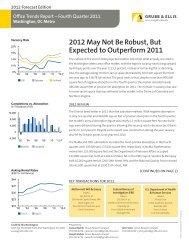Pandemic Preparedness - Grubb & Ellis
Pandemic Preparedness - Grubb & Ellis
Pandemic Preparedness - Grubb & Ellis
Create successful ePaper yourself
Turn your PDF publications into a flip-book with our unique Google optimized e-Paper software.
employee absences to businesses as employees stayed home out<br />
of fear of infection or to care for their families. If avian flu should<br />
spread throughout the United States, estimates claim that it could<br />
kill over 500,000 people, hospitalize more than 2 million, and result<br />
in cumulative labor absentee rates of more than 40 percent for at<br />
least three to four months. It could cost the United States billions<br />
of dollars and the world nearly $2 trillion, disrupting the lives of<br />
millions across the globe. (Bloomberg.com, June 29, 2006; Trust for<br />
America’s Health, 2006).<br />
In light of its global impact and resulting unprecedented absenteeism,<br />
a pandemic event poses many serious challenges to<br />
preparedness and business continuity plans. That a pandemic event<br />
often occurs in successive waves over the course of many months<br />
means that these plans must address both short-term and longterm<br />
issues. Disruptions and uncertainties – including those<br />
affecting power, transportation, telecommunications, water and<br />
public emergency services – only add to the mix of challenges.<br />
Risk reduction and business continuity<br />
Fundamental to business continuity planning are well thought out<br />
risk-reduction strategies. One of the purposes of risk assessment is<br />
to consider additional preventive measures and strategies that could<br />
help reduce the severity of various threats and to proactively implement<br />
procedures or changes quickly where possible and practical.<br />
The aim of business continuity planning is to<br />
mitigate the nearly inevitable business and<br />
economic disruptions that would accompany<br />
a pandemic event.<br />
Disaster recovery outlines the urgent and immediate steps that<br />
need to be taken to get a business up and running after a crisis<br />
event, whereas the aim of business continuity planning is to mitigate<br />
the nearly inevitable business and economic disruptions that<br />
would accompany a pandemic event, lasting more than a few<br />
hours, days or even weeks. Business continuity plans often start<br />
with the identification of essential business functions and activities<br />
(and the personnel and skill sets necessary to keep them running).<br />
In the case of a pandemic, another important aim should be the<br />
minimization and control of illness among employees.<br />
Prior to developing a plan, the following issues should<br />
be considered:<br />
■<br />
■<br />
■<br />
■<br />
Review operations and establish priorities – Determine which<br />
business operations are most critical, and what processes and<br />
resources are required to ensure these operations suffer limited,<br />
if any, interruptions.<br />
Identify roadblocks and ways around them – Outline factors that may<br />
interfere with smooth operations, such as training of personnel,<br />
access to technology, etc., as well as what will be required to navigate<br />
these roadblocks if encountered. Think about what actions<br />
could be taken before a pandemic strikes to reduce its effect on<br />
critical operations and weigh the costs and benefits of early<br />
implementation.<br />
Define the “trigger” for activating your plan – Specify who or what<br />
determines that the company is in “pandemic” mode. Identify<br />
a spokesperson, prepare standard communications that can<br />
be anticipated beforehand and establish a forum for ongoing<br />
dialogue with the organization as well as updates on the status<br />
of the pandemic.<br />
Outline a return to normal operations – Address what happens after<br />
a pandemic. Will there be a swift return to “normal” operations or<br />
will transfer of responsibilities and processes be a slow process<br />
Consider how the organization’s response will be evaluated and<br />
refined in case of a recurrence.<br />
Once developed, the plan should clearly identify:<br />
■<br />
■<br />
Critical operations. Outline those operations that need to be<br />
constantly maintained or recovered within a few hours after an<br />
event, and identify other operations – activities such as marketing<br />
and administrative functions – that can be slated for longer<br />
recovery periods or even suspended completely during an<br />
emergency. Since an avian flu outbreak would constitute an event<br />
that could last weeks or even months, disruptions in this second<br />
category of operations may severely compromise an organization’s<br />
ability to function if continuing widespread absenteeism is<br />
experienced for several weeks. Accordingly, many businesses are<br />
reviewing their current business continuity plans to determine<br />
how they can better take into account the potential difficulties<br />
posed by an avian flu outbreak.<br />
Suspended operations. Outline activities or functions that should<br />
be suspended throughout the duration of an extended outbreak.<br />
Keep in mind the reduction in headcount that is likely to result<br />
from a pandemic illness and anticipate the uncertainty and fear<br />
among those who remain healthy. For example, some businesses<br />
may decide to cancel all non-essential face-to-face meetings<br />
(internal or external).<br />
<strong>Grubb</strong> & <strong>Ellis</strong> Summer 2006 2











